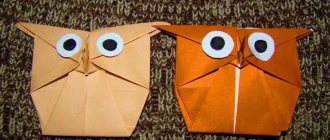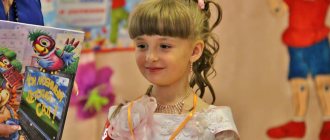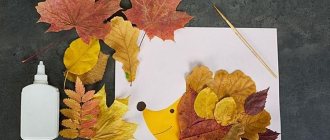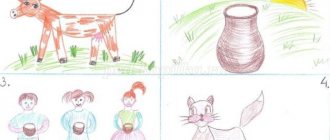Designed from natural materials
Organization of continuous direct educational activities of children in secondary group No. 2
design from natural materials
.
Topic: “
Forest Birds
”
Author of the NNOD summary:
Ustinova Valentina Nikolaevna, teacher, Mikhailovsk MBDOU “Kindergarten No. 20”
Target:
Formation of children's design skills. Make an image of an animal from parts (natural material).
Objectives of the priority educational area:
Educational:
continue to improve constructive skills: connecting parts using plasticine, supplementing the image with details; choose your own means of expression.
Educational:
develop in children imagination, creativity, fine motor skills, interest in the beauty of birds, and the ability to enjoy created crafts.
Educational
: to cultivate an interest in living nature, a kind attitude towards objects of living nature, a desire to provide all possible assistance.
Integration of educational areas
Physical development: increase children’s motor activity in play, develop the ability to correlate words with movements.
Speech development: developing an active vocabulary, strengthening the ability to form an adjective from a noun, selecting synonymous words.
Social and communicative development: the formation of friendly relationships between children, the cultivation of emotional responsiveness.
Artistic and aesthetic development: continue to improve constructive skills and abilities: connecting parts using plasticine, supplementing the image with details; choose your own means of expression.
Cognitive development: develop attention, curiosity, form an idea of the world around you.
Methods and techniques:
gaming, verbal (conversation, posing problematic questions, assignment), visual (attributes, demonstration material).
Prerequisites for educational activities
: develop attention, the ability to listen carefully, perform a task according to a verbal explanation and show a diagram.
Vocabulary work:
We spoke adjectives about spring. Sunny, hot, warm, (selection of synonymous words), we talked about the birds in the poem. We talked about adjectives about birds. Plain, multi-colored or variegated (selection of synonymous words).
Individual work:
work with Dasha B. - help attach the wings of a bird, with Oleg S. - pronouncing words and memorizing a poem.
Preliminary work:
Looking at illustrations, learning poems, guessing riddles about birds, looking at photographs of finished crafts made from natural materials, highlighting the details of the crafts; viewing natural material and experimenting with it; making crafts according to plan in collaboration with the teacher.
MAGAZINE Preschooler.RF
“Applique from natural materials in kindergarten”Designing from natural materials is a creative and useful activity, during which children create original products, while improving their analytical abilities, showing imagination and talent as an inventor.
Children, in addition:
- study the properties of natural materials,
- learn to plan the sequence of their actions,
- learn to select material,
- learn to think through the best option for combining the details of a craft into a holistic image,
- learn to approach product design creatively.
The process of inventing and making such crafts is a source of joy and inspiration, enriches the child’s personality and contributes to its harmonious development, and also cultivates patience and determination.
Learning objectives for the senior group:
- Develop skills in thoughtfully selecting natural materials for constructing a future craft (for example, selecting pine cones, roots and twigs, leaves of the desired size and shape, etc.)
- Learn to see the holistic image of a craft and build it through “objectification” , using basic design techniques.
- To teach design according to plan, the ability to combine crafts into a single plot composition.
- Develop curiosity and creative thinking.
Preparatory group:
- Consolidating and improving the skill of designing according to one’s own design, taking into account the characteristics of the material, the general plot and detail.
- Modeling a holistic image using the “inclusion” , when a child analyzes natural material and learns to see in it not only the basis (for example, the body of a bear cub), but also an additional important detail, for example, a bell or a basket.
Types of crafts by technique:
- Construction is the creation of three-dimensional crafts by combining individual fragments and elements into a holistic image.
Types of design and application from natural materials:
Object design - a single three-dimensional figure or applique (butterfly, flower, donkey, cat, gnome, etc.).
Story composition ( “At the Zoo” , “Forest School” , “Princess Birthday” , etc.) - children work in subgroups or collectively, compose and tell fairy tales, give verbal characteristics to their characters, create living images (the good turtle , a playful bunny, an important elephant), make up a single composition from individual figures based on an independently invented plot or “revival” of the heroes of your favorite fairy tales and cartoons.
Creation of large compositions on the territory of the kindergarten: planar (a carpet of leaves, sticks, pebbles, shells), as well as volumetric (a medieval city with a castle and houses, surrounded by a fortress, drawbridges and ditches, or a cosmodrome with rockets and robots). This is a group work that takes up to several weeks.
Craft modeling techniques:
- change of location in space - the child carefully examines the material, imagines what figure the natural configuration resembles, turns the roots and branches in different directions;
- the method of “completing” the image - the child fixes the material on a stand in a certain spatial position and complements the original image with the help of parts from another natural material or plasticine, creating, for example, a figurine of a hedgehog, dog, princess or acrobat;
- combination method - creating plot compositions from several figures;
- a way to “remove the excess” - the child breaks off the extra branches, and then adds the necessary details, for example, a head, and gets the image of a clown.
Material is usually collected on a summer or autumn day in a park, garden, forest, summer cottage, field - during a family vacation, pleasant walks or exciting excursions. It is worth remembering that the texture and shape of unripe berries and seeds changes when dried.
Nature generously gives us rich material for creativity. You just have to turn on your imagination - and ordinary chestnuts, bizarrely shaped branches and roots, fluffy cones will turn into amazing fairy-tale people or be transformed into an original interior decoration. Classes on making crafts from natural materials in kindergarten not only develop fine motor skills, analytical thinking, sensory skills and train the eye, but also give every child a sea of positive emotions and the joy of contact with the world of beauty.
| Next > |
Artistic design from natural materials in kindergarten
A variety of natural materials are widely used in the constructive activities of preschool children. The main task of the teacher is to teach to feel the specificity of natural material, to see the diversity of its colors, shapes, textures and on this basis to create a variety of artistic images.
The implementation of tasks, on the one hand, develops imagination and creativity, on the other hand, leads children to master a generalized method of constructing an image based on clarity.
In studies of the development of considerations in preschool children, O. M. Dyachenko identifies two main qualitatively different methods of action for constructing an imaginary image:
1) “objectification”, when a child sees a certain object in an unfinished drawing;
2) “inclusion”, when the figure specified in the drawing turns into a secondary element of the imaginary image.
For the development of creative imagination it is fundamentally important:
- develop in children the ability to analyze material, first as the basis of a future image created by the “objectification” method, then as a detail significant for constructing a holistic image using the “inclusion” method;
- to develop such design skills and techniques as “completing” the image, “changing the spatial position”, “removing unnecessary things”, “combining”.
Main tasks of the first stage of training
constructive skills in making crafts from natural materials:
- develop the ability to analyze natural material as the basis for a future craft (select roots, branches, twigs);
— teach three basic techniques for constructing an image using the “objectification” method: the ability to change the spatial arrangement, complete construction, and remove unnecessary things.
The “objectification” method is fundamental, since it allows you to develop the ability to see the whole before the parts.
1st-2nd lessons:
— consideration of natural material;
— highlighting various images in configurations;
— construction of two or three images on one basis.
3-4th lessons:
- tasks of a problematic nature are given: the task is to create crafts based on a given basis;
— new materials are offered: pieces of tree bark of different sizes and configurations, dry tree mushrooms (as a base).
5-6th lessons:
- design is carried out according to plan.
Having determined the idea, children independently select natural materials: large ones are used as the basis of the craft, small ones are used as details.
At the second stage
The following main tasks are solved:
- develop the ability to build an image using the “inclusion” method;
- analyze natural material not only as the basis of a future craft, but also as a detail significant for constructing a holistic image (the same material can be both the basis of a craft and its detail).
1st lesson: design according to your own plans from material collected during the excursion.
2nd lesson: design according to your own design from a certain natural material obtained as an element of a future craft;
3rd lesson: completing the construction of a figure based on cross-shaped sticks-twigs;
Lesson 4: completing a figure based on two connected acorns, alder cones on a branch, straw tied in a certain place, pieces of bark with a stick fixed in the center.
Main tasks of the third stage
:
— expand the basic ways and techniques of building an image;
- to develop the ability to implement a plan, taking into account the general plot, detailing and enriching the image, and the specifics of the natural material.
Learning to design according to your own plot is the main goal.
1st-2nd lessons:
- constructing an invented fairy tale or story based on the plot.
Artistic design from natural materials
Middle group
Main goals
- develop the ability to analyze natural materials as the basis for future crafts;
— teach three basic techniques for constructing an image using the “objectification” method: changing the spatial arrangement, completing construction, removing unnecessary things.
Technical skills of children
Fastening with plasticine; fastening with glue.
Teacher's help
Helps to break off and cut off excess parts; helps attach additional parts, deepen the gap (mouth, beak).
Material for work
Roots, branches, twigs, pieces of tree bark, dry tree mushrooms, small natural material.
Senior group
Main goals
- develop the ability to build an image using the “inclusion” method;
- to develop the ability to analyze natural material not only as the basis of a future craft, but also as a detail significant for constructing a holistic image, by including it in this integrity;
— expand the basic ways and techniques of building an image;
- develop the ability to implement a plan.
Technical skills of children
Fastening with plasticine; fastening with glue; fastening with colored thin wire.
Teacher's help
Working with an awl; working with a knife; varnishing
Material for work
Cones, acorns, chestnuts, shells, alder cones on a branch, straw, bark, small natural material.
Stages of introducing natural material
Stages of introducing natural material in the middle group:
1st stage
Type of material:
roots, branches, twigs, small natural material.
2nd stage
Type of material:
pieces of tree bark of various sizes and configurations, dry tree mushrooms, small natural material.
Method of action
“Objectification”: change in spatial arrangement; completion; removing excess.
Stages of introducing natural material in the senior group:
3rd stage
Type of material:
cones, acorns, chestnuts, shells, small natural material.
Method of action
“Inclusion”: the use of natural material not only as the basis for a future craft, but also as part of the whole; multifunctional use.
4th stage
Type of material
: two sticks-twigs, fastened in the middle.
Method of action
Completing the figure.
5th stage
Type of material: two connected acorns, alder cones on a branch, straw tied in a certain place, pieces of bark with a stick fixed in the center.
Method of action
Completing the figure.
6th stage
A variety of natural materials.
Method of action
Application of all methods.
Design in kindergarten: approximate long-term calendar planning / ed. T. A. Kruglenya. – 2nd ed. – Minsk: Zorny Verasok, 2021. – 67 pp., pp. 12-14.
Abstract of GCD for design in the senior group. Wintering birds
Abstract of the GCD for the design of “Wintering Birds”
Integration of educational areas - cognitive, speech, social - communicative, physical and artistic-aesthetic development Goal : to form a spatial and visual understanding and consolidate knowledge about wintering birds. Objectives : - expand children's understanding of wintering birds; — consolidate the ability to identify the main parts and characteristic details of structures; — act according to the algorithm based on the diagram; - act according to verbal instructions; — improve the dialogical form of speech, encourage attempts to express one’s point of view; — to cultivate hard work, a conscientious and responsible attitude to the work performed, and the ability to cooperate with other children. Material : films “Bullfinch” and “Tits”, TIKO “Baby” construction set for each child, individual cards - diagrams of plane figures “Birds”. Forms of organization: group, frontal, individual.
Preliminary work: games with the TIKO constructor, reading fiction about wintering birds. Progress of the lesson.
Educator: - Guys, what time of year is it now? How did you guess? (Children's answers) Today in class we will talk about birds that remain and live next to us, despite the cold, snowy winter. • Greenish on the back, yellowish on the belly, a black little paw and a stripe of a scarf. (Tit) (Children's answers are accompanied by photo slides) • Every year I fly to you. I want to spend the winter with you. After all, it’s even redder in winter. My bright red tie. (Bullfinch) Educator: With the onset of cold weather, many birds fly south to hot countries. And bullfinches only come to us in winter. They are called bullfinches because they appear with the snow. It is not difficult to see these birds in winter; their red breasts, bluish-gray backs, black velvet caps and wings are clearly visible against the background of white snow. Females have gray breasts. Bullfinches feed on weed seeds and berries that can be found in our forests in winter, rowan berries. In spring, bullfinches will already be in the forest. They will build nests there, hatch and feed the chicks. • In a gray feather coat and in the cold he is a hero. Jumps and frolics on the fly. Not an eagle, but still a bird. (Sparrow) - Sparrow is a small bird. It has gray-brown plumage, a small sharp beak, a small body, a short tail, and thin legs. It feeds on bread crumbs, berries, grains, and seeds. Sparrow is nimble, fast, dexterous, pugnacious, fighting, brave. If the sparrow gets ruffled, then expect severe frost tomorrow. - Sparrow, tit, bullfinch... What kind of birds are these? (Wintering) - What other wintering birds do you know? (Dove, crow, woodpecker, magpie, crossbill, cuckoo, etc.) (Pictures of wintering birds are displayed.) - What do all birds have in common? (Torso, wings, feathers, beak, paws, tail.) - How are they different? (Size, color, plumage.) - What is the body of birds covered with? -What are feathers for? — Each bird, like a person, has its own character. What do you think is the character of the bullfinch? What kind of tit? What can you say about the sparrow? - Do you know how these birds voice? - Sparrow - chirps. The tit and bullfinch whistle when they are full, and if they are cold and hungry, they hiss. The crow caws. The dove is cooing. The magpie is crackling. — Birds are hungry and cold in winter. People take care of them and make bird feeders. Didactic game “Say the opposite”. The sparrow has a small body, and the crow has ... (large) The crow has a large beak, and the sparrow has .... The sparrow has a short tail, and the crow has…. A sparrow has thin legs, and a crow has thin legs... etc. Physical exercise. Birds jump, fly, Children jump, “fly”,
Birds jump, sing,
“sing”,
Birds collect crumbs.
“gathering”,
grains are pecked.
“they peck”,
The feathers were cleaned, The beaks were cleaned, The beaks were cleaned, Then they flew
“fly away”,
And sat down.
sit down.
1. Design of TIKO “Bird”.
We recommend watching:
Design for older preschoolers Summary of an integrated lesson on designing from various materials in the senior group Summary of GCD for design in kindergarten in the senior group Summary of GCD for speech development in the preparatory group. Wintering birds
Similar articles:
Coloring pages "Wintering birds" for kindergarten
Construction as a type of children's creativity
Definition 1
Construction is the process of constructing an object, bringing various parts, elements and objects into a certain relative position.
Construction is a type of children's activity during which the child constructs a specific object (according to a scheme, plan, spontaneously, etc.). Construction occurs by composing parts or elements (cubes, building material, natural material, waste material, etc.) in any order, depending on the type of construction.
Construction is of great importance in the development of a preschool child, in his mastery of various types of practical activities. By its nature, construction is a productive type of children's activity.
Are you an expert in this subject area? We invite you to become the author of the Directory Working Conditions
The main feature of design is that it is creative in nature, as it is aimed at obtaining a specific expected product. In addition, design is also defined as a special experimental research and search activity aimed at obtaining a total product consisting of individual elements. Also, a number of researchers consider design from a creative point of view.
In the design process, the child uses a variety of materials that have different characteristics (size, shape, tactile sensations, etc.). By constructing from various materials, the child learns to generalize, masters universal skills for constructing a single whole from a set of elements.
Definition 2
Creative design is a complex system of practical and mental actions aimed at solving a specific constructive problem.
Finished works on a similar topic
Course work Designing from natural materials as a means of developing children's creativity 410 ₽ Abstract Designing from natural materials as a means of developing children's creativity 260 ₽ Test work Designing from natural materials as a means of developing children's creativity 210 ₽
Receive completed work or specialist advice on your educational project Find out the cost
Creativity in construction consists in the fact that a child, while engaged in construction, carries out such processes as thinking and planning his upcoming activities, translating an incipient mental concept into a real creative product.
Note 1
Thus, children's creative construction has a comprehensive impact on the child's development. It promotes the formation of a variety of practical skills, as well as the development of speech, memory, thinking, imagination and fantasy of the child.
Preparing natural materials for creating crafts
Materials brought from the forest are thoroughly cleaned of insects and debris. The buds are dried in the oven at 2500 for half an hour or in the microwave for 1 minute. at maximum power so that they open.
The leaves are dried either by ironing with a hot iron between layers of paper or the old fashioned way - between the pages of a book.
Shells are usually washed during rest, but upon arrival they should be washed again with the addition of bleach (you can use “Whiteness”) and dried on paper.
Stones should be washed with soap and water and dried.
Seeds, moss, and lichen can be dried on paper on a table or windowsill, and the branches can simply be placed in a vase without water.
If dried materials are not immediately used, put them in a large box or container so that they do not break or collect dust.




